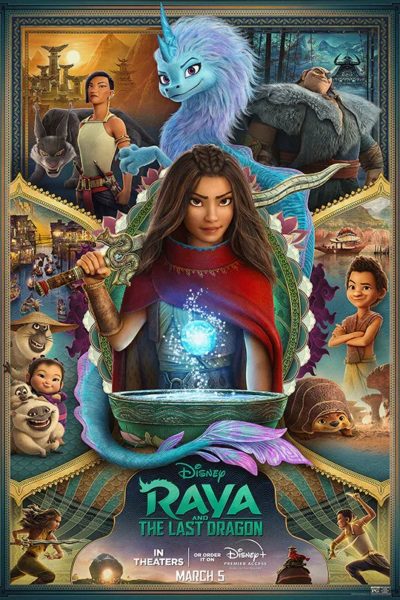★★
“Pretty, but pretty problematic.”
 It had been close to five years since I saw my last Disney animated feature (Finding Dory, should you be interested). But the trailer for Raya got me intrigued. This seemed a genuinely kick-ass heroine, something absent from their output since Brave. Sadly, while I have to say the action is impressive and it looks good, these elements aren’t enough to overcome weaknesses, most obviously in the story department. It felt very much like it was written by a committee that had been handed a set of required talking points. And, lo, the end credits reveal the story was by eight different people, with four directors. I’m just glad I did not pay the House of Mouse’s $29.99 fee, or my disappointment would probably turn into annoyance.
It had been close to five years since I saw my last Disney animated feature (Finding Dory, should you be interested). But the trailer for Raya got me intrigued. This seemed a genuinely kick-ass heroine, something absent from their output since Brave. Sadly, while I have to say the action is impressive and it looks good, these elements aren’t enough to overcome weaknesses, most obviously in the story department. It felt very much like it was written by a committee that had been handed a set of required talking points. And, lo, the end credits reveal the story was by eight different people, with four directors. I’m just glad I did not pay the House of Mouse’s $29.99 fee, or my disappointment would probably turn into annoyance.
It’s set in the fictional country of Kumandra, a world inspired by various Southeast Asian cultures. [This hasn’t stopped Disney from being the target of PC critics, e.g. for casting voice actors outside that region… yeah, as inhabitants of a fictional country. When you start feeding the woke monster, never expect its appetite to be satisfied] Aided by dragons, Kumandra had lived in peace until attacked by the Drune, evil spirits that turn their victims to stone. They are eventually defeated, but at the cost of the dragons, and the land fractures into five separate countries. 500 years later, the bickering territories fight for control of the orb containing the dragons’ magic. It’s broken in the struggle and the Drune return. It’s up to orb guardian, Raya (Tran) to reassemble the pieces, with the help of final surviving dragon, Sisu (Awkwafina).
A straightforward quest would have been perfectly fine, the heroine facing an escalating series of exciting challenges as she retrieves each fragment. But the film instead dumps so much extra on top, that this actual core becomes almost irrelevant. In many cases, recovering a fragment is super easy, barely an inconvenience, because the film has to hurry back to all the other things on its to-do list. For example, it’s considerably more interested in promoting a “one world” ethos, in which the countries must be made to unite. There’s no room here for alternative opinions, such as the possibility that, after five centuries of independence, they have their own cultural identities and might not necessarily be best served by forced amalgamation, at the point of a dragon.
It also has to handle too many supporting characters. Things are fine early on, when it’s just Raya and Sisu. They have a relationship that’s fun to watch, even if it’s derivative of the Mulan/Mushu one. But the film throws in sidekick after sidekick. Boun, their 10-year-old boat captain (guess Disney has no issues with child labour…). Little Noi and her gang of monkeys. Tong, a Warrior from the Spine land. It’s all too much. On the other hand, there’s no real antagonist. Disney has had some great villains in the past, from Cruella de Vil to Scar. But here the Drune don’t work at all, being nothing more than smokelike entities. You might as well try to make COVID-19 your bad guy.
Some may argue a case for Namaari (Chan), a princess from the Fang tribe, whose deceit of Raya leads to the shattering of the orb. However, it seemed painfully obvious. almost from the get-go, that there was eventually going to be a face turn in her future. That became particularly clear after she started questioning her mother (Sandra Oh). However, I think it was fairly apparent, simply by her character design. From the haircut to her clothes, Namaari could not have been more LGBTQIA+ friendly if they’d given her Birkenstocks and a box-set of The L Word. Not that there’s anything wrong with that, but Woke Disney is never going to have a genuine villain who looks so utterly gay.
Positives? As mentioned, there’s a rich visual style, and the animation is incredibly fluid. The action scenes are particularly well-done, not least the battles between Namaari and Raya. Animated fights often lack impact; that certainly isn’t the case here. In particular, the artists take advantage of the ability to make things quicker than humans could possibly be, without it ever seeming like the film has been sped-up. Some of the jokes work well, with Awkwafina’s comic timing particularly good. There were moments when Sisu reminded me of Dory, in her scatterbrained nature, and there are few higher compliments I can offer than that.
Yet the impact diminished the longer it went on, with every moral lecture and additional character thrown into the mix. The ending is clearly intended to be some kind of stirring emotional climax, yet left me entirely cold, perhaps because there’s no real threat. We’re told at the start that when the Drune were defeated, the people they petrified return to life. So even seeing Raya turn to stone seems, again, barely a temporary inconvenience. Still, at least there were no crappy songs until the end credits. I guess that’s something for which I should be grateful.
Dir: Don Hall, Carlos López Estrada, Paul Briggs, John Ripa
Star (voice): Kelly Marie Tran, Awkwafina, Gemma Chan, Izaac Wang





